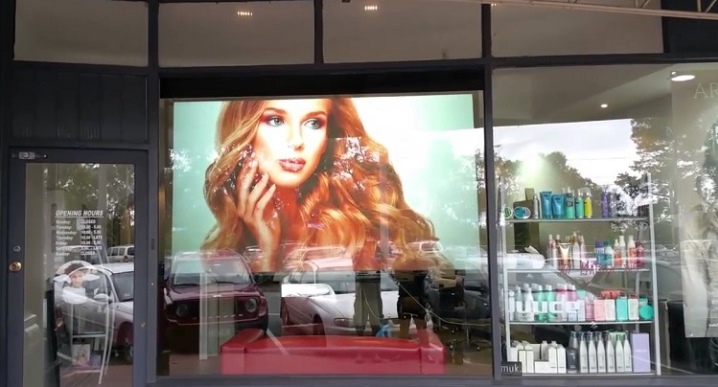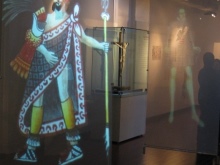All About Rear Projection Film

At the very beginning of the XXI century, a technical breakthrough occurred on the projection equipment market - the American company 3M invented a rear projection film. The idea was taken up by the Netherlands, Japan and South Korea, and since then this product has continued its triumphant march around the world. In the article, we will figure out what a rear projection film is, consider its varieties and applications.


What it is?
To understand how rear projection works, you just need to remember how video is played in a movie theater or how a conventional film projector works. In these versions, the source of the image transmission (the projector itself) is located on the front side of the screen, that is, it is located on the same side with the audience. In the case of rear projection, the equipment is located behind the screen, due to which a higher quality of the transmitted image is achieved, the image becomes clearer and more detailed. Rear-projection film is a thin polymer with a multi-layer microstructure.

The material can be used both in interaction with special screens, and as an independent element for creating a display. In the latter case, the film is glued to glass or acrylic surface and, using a projector, a screen is obtained that can display any kind of image. The fact that the projector is located directly behind the glass is an important advantage: the film is widely used in outdoor advertising, for broadcasting video on store windows.
Moreover, it is easy to apply to the surface. A few simple rules, and any glass facade will turn into a broadcast of images.

Product types and overview
First of all, the projection film may differ in manufacturing technology.
- The creation of a coating that scatters, "pushes" excess light from the surface, so that any image distortion disappears.
- The use of absorbent and microlenses. Since the projector supplies the image to the surface at an angle of 90 °, the beam is immediately refracted in the lenses. And extraneous light from the outside falls on the screen not at a right angle, it is delayed and scattered.

Visually, the film is also classified according to color criteria.
- Transparent. The most common and traditional option for window dressing. The material is capable of transmitting 3D images, holography, and creating the effect of floating in zero gravity. However, this film has its own peculiarity: in the sun and in brightly lit rooms, the image contrast is extremely low. Transparency film is successfully used in places where the picture is broadcast only in the dark. For example, a shop window with applied film of this type will be transparent during the day, and showing a video sequence at night.
- Dark gray. Ideal for indoor use as well as for broadcasts in bright sunlight outdoors. Provides the highest picture contrast and brightness.
- White (or light gray). Unlike other options, it is characterized by low contrast. It is most often used in interior design, as well as when creating advertising in the form of volumetric rotating letters and logos. As a rule, two-sided mirror projection is used on such objects.
- Black with lenticular structure. The quality of the transmitted image is superior to the previous version.It is a two-layer material with microlenses between the layers.


Another type of rear projection film, interactive, stands apart. In this case, an additional sensory layer is applied to the material, thanks to which any transparent surface, be it a shop window or an office partition, becomes a capacitive multitouch panel.
The sensor film can be of different thickness.
- The thin one is used for presentation screens, it can be used with a special marker, which is convenient for indoor presentations. The surface will also respond to finger touch.
- The thickness of the sensor substrate can reach 1.5-2 cm, which makes it possible to use the interactive film even for the design of bulky shop windows.


Where is it used?
In the modern world, high technologies are found almost everywhere. It is difficult to imagine big cities without ads, video ads, and offices - without presentations with a demonstration of pictures. Rear-projection film is widely used in the creation of video sequences in the windows of boutiques and shopping centers, in cinemas and museums, in airports and train stations. Increasingly, it is also used for internal broadcasting of images in educational institutions, institutions of various kinds.
In addition, at present, designers are increasingly resorting to such material in decorating office and even residential premises.



Main manufacturers
Among the variety of modern rear projection film brands, there are several internationally renowned companies with excellent reputations.
- American company "3M" - the ancestor of products, produces the most expensive and high-quality goods. The price for one square meter of film reaches one and a half thousand dollars. The material is characterized by high image clarity and good reproduction of bright colors in any light. The film is black, has microlenses in its structure. The surface is protected by an anti-vandal layer.

- Japanese manufacturer Dilad Screen offers rear projection film in standard types: transparent, dark gray and white. High quality material eliminates image distortion. The dark gray variety diffuses sunlight well. As in the previous version, the products have an anti-vandal coating. Cost for 1 sq. meter varies between 600-700 dollars.

- Taiwanese firm NTech supplies film to the market in three traditional versions (transparent, dark gray and white). The quality of the product is not very suitable for the use of the film in outdoor conditions (scratches often remain on the material, there is no anti-vandal coating), but this variety is successfully used in closed auditoriums. The advantage is the price - $ 200-500 per 1 sq. meter.

How to stick?
It is not difficult to apply a rear projection film, but it is important to take into account some nuances in the process. First you need to carefully prepare the surface. For this you will need:
- wipes for cleaning glass (lint-free, so that the smallest particles do not remain on the panel, which can subsequently distort the image);
- soap solution or dishwashing detergent (to completely degrease the surface);
- spray;
- pure water;
- soft roller.


The application technology includes several steps.
- A cleaned glass or acrylic surface should be moistened with clean water from a spray bottle.
- Carefully separate the protective layer from the film. Attach base material to the prepared panel. It should be borne in mind in advance that high-quality film application on volumetric surfaces cannot be done alone.
- After applying the film, it must be processed with a soft roller, smoothing over the surface. This is done in order to remove the smallest air and water bubbles (by analogy with a wallpaper sticker).
Advice: it is optimal if a glass panel is used for applying the film, since air bubbles can subsequently appear on the surface due to the high plasticity of acrylic sheets.


In the following video, you can take a look at the high contrast rear projection film from ProDisplay at the Hitachi booth.













The comment was sent successfully.